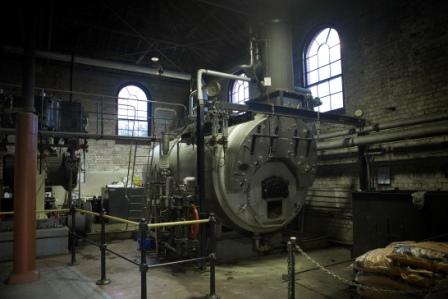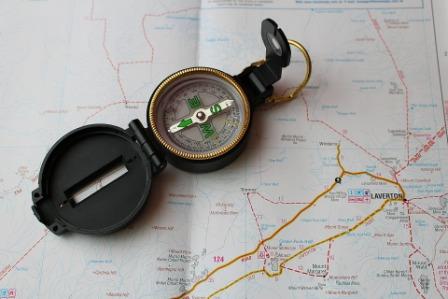Types of boilers:
- Water tube type: this type of boiler is used for high pressure, high temperature, high capacity steam applications eg for main propulsion turbines or cargo pump turbines.
- Fire tube type: used for low-pressure steam on diesel engine powered ships.
Saturated steam is the steam which is in physical contact with the boiling water. Its temperature is same as that of the boiling water from which it has been produced. This temperature is referred to as saturated temperature. If the vapor produced does not contain any water droplets it is known as dry steam otherwise it is known as wet steam.
Superheated steam: steam whose temperature is higher than its saturated temperature corresponding to its pressure is known as superheated steam. When steam is superheated its volume increases. In order to raise the temperature of saturated steam, it is taken away from the water with which it is in contact and heated externally. As superheated steam is at a greater temperature and greater volume, it has more heat energy in each kilogram. This extra energy can produce more power thereby increasing efficiency.
Advantages of superheated steam
1. For the same power of the engine, less steam is used. Thus less fuel is used.
2. If there are no water particles, less likelihood of hammering, less initial impact loss and less erosion of turn blades
disadvantages of superheated steam
1. Is not suitable for reciprocating machinery as there are no water particles to act as a lubricant on shuttle and slide valve faces and piston rings.
Economiser: an economiser is used to transfer heat from hot waste gases to boiler feed water. The heat which would have been lost in the atmosphere is used to heat the feed water, thus less heat is required from fuel burning, this increases efficiency and results in economy.
Boiler gauge glass
this glass is used to see the level of water in the boiler. It has three cocks, a steam cock, water cock and drain cock. A ball valve is fitted to the lower end of the glass gauge in order to shut off the supply of hot water in case of glass fracturing.
Method to blow down the gauge glass
1. Close the steam and water cock and open the drain cock. If nothing blows out of it then the steam and water cocks are holding good, otherwise, they are leaking.
2. Open and close the water cock to check if the water cock connection is clear.
3. Open and close the steam cock to check if the steam cock connection is clear.
4. Close the drain valve.
5. Open the water cock, water should gradually rise to the top of the glass gauge.
6. Open the steam cock, the water level should gradually fall to the level of water in the boiler.
Safety valve
a safety valve is a device fitted to the boiler to prevent overpressure. The regulation demands a minimum of two safety valves to be fitted to the boiler.
The valves are required to be:
1. Set to blow off at a pressure not exceeding 3% of the working pressure,
2. Designed so that, under full firing conditions of the boiler with the steam stop valve fully shut, the valve must lift sufficiently so that the pressure does not rise above 10% of designed blow-off pressure. I.e. Valve should not allow the steam to accumulate. It is also called as the accumulation test of the boiler. Specially shaped lips on the valve and seat assist in minimising accumulation of steam pressure.
The safety valves are fitted with a hand operated easing gear by which the valves can be manually floated in case of emergency.
Main steam stop valve and auxiliary steam stop valves
these are screw down type non-return valves fitted on the main and auxiliary steam lines. They are either fully shut or fully open
blow down valve
these are two valves mounted in series to the water drum of the boiler. It enables to blow out the water in the water drum to reduce its density. Normally while blowing down, the first valve is fully open and the second valve is cracked open, to get the required flow rate. It is done to avoid the seat of the first valve from getting damaged and thus prevents leakage.
Soot Blowers
over a period of time carbon deposits build up on the gas side heating surfaces of the boiler. These need to be cleaned as they may lead to corrosion and also uptake fires. Soot blowers are fitted to clean up these carbon deposit. These are operated by steam or compressed air. They act to blow away soot and products of combustion from the tube surfaces. Several soot blowers are placed at strategic positions.
Water carryover
water carryover may be caused by impurities in the water, which foam up as the water boils or by high water level.
If large quantities of water are carryover it may cause:
1. In mechanical or thermal shocks that may cause damage to the system components such as turbine parts, valves, and any reciprocating steam machinery if used.
2. Deposits in the superheater and on turbine blades with serious consequences.
3. Erosion of parts.
4. Lubrication to be washed away in reciprocating machinery. Since water is incompressible, water trapped in cylinders can cause the fracture.
The most common practice to avoid carryover is:
1. To maintain the concentration of solids in the boiler water at reasonably low level.
2. Avoiding high water levels, excessive boiler loads, sudden load changes.
3. By using chemical antifoaming and anti-priming agents.
Hotwell And Sight Glass
1. It is a tank from where the feed pump transfers feed water to the boiler when the water level in the boiler falls.
2. If the water level in the hot well falls, water is transferred to it from the feed water tank.
3. Steam returns from heaters and tanks condense in a condenser and condensate goes to the hot well.
4. The hot well is covered to prevent oxidation of feed water is kept hot – to a recommended temperature.
5. There are filters in the hot well to trap any contaminants. These filters must be examined and cleaned regularly.
6. Steam is used to heat fuel oil tanks or fuel and lube oil heaters, thus the steam can be contaminated by leakage in the coils. Therefore a sight glass is provided in the hot well, through which the watchkeeper can see the contents of the hot well and notice any contamination.
Boiler Water Test
boiler water test is done to determine whether any chemical treatment is required. Also if chemicals and chlorides are excessive then blowdown may be necessary.
The main reasons for chemical treatment are:
1. To prevent corrosion in boiler, steam and condensate system,
2. Prevention of scale formation, which can reduce heat flow from the fireside to the waterside leading to inefficiency.
3. Prevention of carryover in the steam of suspended solids and soluble salts.
Some Boiler Water Tests Are:
1. Alkalinity test: to determine the alkalinity of the water.
2. Chloride test: to determine the contents of chlorides in the water.
3. Excess phosphates test: to determine the number of phosphates which are added to the water to treat scale-forming salts.
4. Hydrazine test: to determine the quantity of hydrazine in the boiler water, which is used to treat dissolved oxygen in the water as oxygen aids in corrosion.
Maintenance To Be Done On Boilers
1. Waterside:
1. Carry out boiler water test regularly.
2. According to the test results add chemicals as required.
3. Preferably use the water produced by the freshwater generator as shore water is likely to contain impurities.
2. Smoke side:
1. Carry out soot blowing regularly.
2. Keep combustion equipment in good order so that unburnt particles and soot formation is minimized.
3. Smoke tubes are to be physically brushed clean periodically.
Lighting Up Of Boiler And Process Of Raising Steam From Cold
1. Fill the boiler with water to about one-quarter of the glass guage, make sure the air vent is open.
2. Make sure that there is no oil lying in the furnace, as this can produce flammable vapors and when a naked light is shown it can cause an explosion. Accidents have occurred in the past because of negligence.
3. Air should initially be blown in the boiler to sweep out traces of any flammable gases from the furnace.
4. To light the fire, open air supply to the furnace. When the thermometer on the boiler front indicates the correct temperature of the oil, put the lighted torch in the furnace and open oil to one of the burners at a rate as slow as possible.
5. Raise the temperature of boiler water at a rate of 6-7oc per hour.
6. Close the air vent when steam vapors begin to show up.
7. Raise steam pressure slowly in the next 1 hour to within 2bars of the working pressure.
8. Test water gauge by blowing through. Check boiler pressure gauge, check safety valve.
9. Firing rate may now be increased.
10. The boiler is ready to supply required steam.
Preparing A Boiler For Survey
1. Before a boiler, survey confirms the time available and the requirement of steam in the next port.
2. Check for the necessary spares that may be required, such as manhole door joints, glass guage, packing etc.
3. Change over the boiler from automation to manual and shut down the boiler firing.
4. Cut off the power for fuel oil pump, feed pump, and combustion control panel.
5. Shut off the main steam valve and auxiliary steam valve. Post necessary notices.
6. When the boiler pressure is about 4 bars and it is cooled down, carry out blow down.
7. When the boiler pressure is slightly higher than the atmospheric pressure, open the vent cock to prevent the formation of a vacuum.
8. Once the boiler is sufficiently cooled down, open the top manhole cover.
9. Let the boiler cool down further and then open the bottom manhole door and the furnace door.
10. Let the boiler ventilate for a period of 12-24 hours.
11. Check for oxygen content and then prepare for man-entry.




